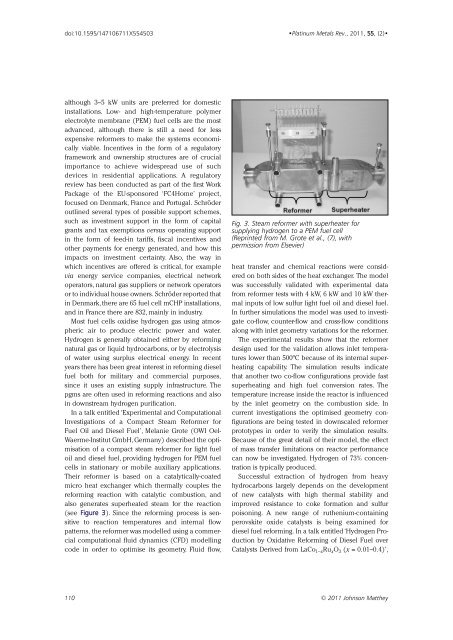Download - Platinum Metals Review
Download - Platinum Metals Review
Download - Platinum Metals Review
You also want an ePaper? Increase the reach of your titles
YUMPU automatically turns print PDFs into web optimized ePapers that Google loves.
doi:10.1595/147106711X554503<br />
•<strong>Platinum</strong> <strong>Metals</strong> Rev., 2011, 55, (2)•<br />
although 3–5 kW units are preferred for domestic<br />
installations. Low- and high-temperature polymer<br />
electrolyte membrane (PEM) fuel cells are the most<br />
advanced, although there is still a need for less<br />
expensive reformers to make the systems economically<br />
viable. Incentives in the form of a regulatory<br />
framework and ownership structures are of crucial<br />
importance to achieve widespread use of such<br />
devices in residential applications. A regulatory<br />
review has been conducted as part of the first Work<br />
Package of the EU-sponsored ‘FC4Home’ project,<br />
focused on Denmark, France and Portugal. Schröder<br />
outlined several types of possible support schemes,<br />
such as investment support in the form of capital<br />
grants and tax exemptions versus operating support<br />
in the form of feed-in tariffs, fiscal incentives and<br />
other payments for energy generated, and how this<br />
impacts on investment certainty. Also, the way in<br />
which incentives are offered is critical, for example<br />
via energy service companies, electrical network<br />
operators, natural gas suppliers or network operators<br />
or to individual house owners. Schröder reported that<br />
in Denmark, there are 65 fuel cell mCHP installations,<br />
and in France there are 832, mainly in industry.<br />
Most fuel cells oxidise hydrogen gas using atmospheric<br />
air to produce electric power and water.<br />
Hydrogen is generally obtained either by reforming<br />
natural gas or liquid hydrocarbons, or by electrolysis<br />
of water using surplus electrical energy. In recent<br />
years there has been great interest in reforming diesel<br />
fuel both for military and commercial purposes,<br />
since it uses an existing supply infrastructure. The<br />
pgms are often used in reforming reactions and also<br />
in downstream hydrogen purification.<br />
In a talk entitled ‘Experimental and Computational<br />
Investigations of a Compact Steam Reformer for<br />
Fuel Oil and Diesel Fuel’, Melanie Grote (OWI Oel-<br />
Waerme-Institut GmbH, Germany) described the optimisation<br />
of a compact steam reformer for light fuel<br />
oil and diesel fuel, providing hydrogen for PEM fuel<br />
cells in stationary or mobile auxiliary applications.<br />
Their reformer is based on a catalytically-coated<br />
micro heat exchanger which thermally couples the<br />
reforming reaction with catalytic combustion, and<br />
also generates superheated steam for the reaction<br />
(see Figure 3). Since the reforming process is sensitive<br />
to reaction temperatures and internal flow<br />
patterns, the reformer was modelled using a commercial<br />
computational fluid dynamics (CFD) modelling<br />
code in order to optimise its geometry. Fluid flow,<br />
Fig. 3. Steam reformer with superheater for<br />
supplying hydrogen to a PEM fuel cell<br />
(Reprinted from M. Grote et al., (7), with<br />
permission from Elsevier)<br />
heat transfer and chemical reactions were considered<br />
on both sides of the heat exchanger. The model<br />
was successfully validated with experimental data<br />
from reformer tests with 4 kW, 6 kW and 10 kW thermal<br />
inputs of low sulfur light fuel oil and diesel fuel.<br />
In further simulations the model was used to investigate<br />
co-flow, counter-flow and cross-flow conditions<br />
along with inlet geometry variations for the reformer.<br />
The experimental results show that the reformer<br />
design used for the validation allows inlet temperatures<br />
lower than 500ºC because of its internal superheating<br />
capability. The simulation results indicate<br />
that another two co-flow configurations provide fast<br />
superheating and high fuel conversion rates. The<br />
temperature increase inside the reactor is influenced<br />
by the inlet geometry on the combustion side. In<br />
current investigations the optimised geometry configurations<br />
are being tested in downscaled reformer<br />
prototypes in order to verify the simulation results.<br />
Because of the great detail of their model, the effect<br />
of mass transfer limitations on reactor performance<br />
can now be investigated. Hydrogen of 73% concentration<br />
is typically produced.<br />
Successful extraction of hydrogen from heavy<br />
hydrocarbons largely depends on the development<br />
of new catalysts with high thermal stability and<br />
improved resistance to coke formation and sulfur<br />
poisoning. A new range of ruthenium-containing<br />
perovskite oxide catalysts is being examined for<br />
diesel fuel reforming. In a talk entitled ‘Hydrogen Production<br />
by Oxidative Reforming of Diesel Fuel over<br />
Catalysts Derived from LaCo 1−x Ru x O 3 (x = 0.01–0.4)’,<br />
110 © 2011 Johnson Matthey
















